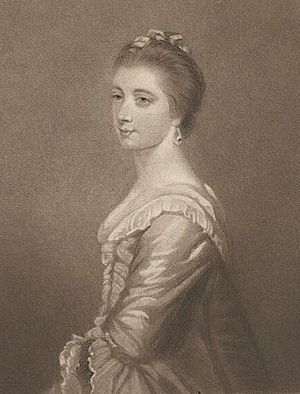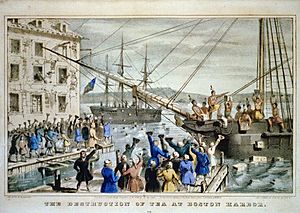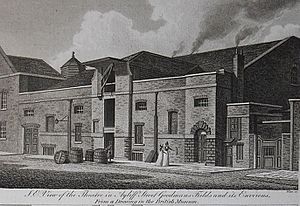Mary Hayley facts for kids
Quick facts for kids
Mary Hayley
|
|
|---|---|

Engraving by Samuel William Reynolds (1821) of "Mary Wilkes (Mrs. Hayley)" by Sir Joshua Reynolds (1763)
|
|
| Born |
Mary Wilkes
30 October 1728 Clerkenwell, London, England
|
| Died | 9 May 1808 (aged 79) Bath, England
|
| Nationality | English |
| Other names | Mary Storke, Mary Haley, Madame Hayley, Mary Jeffery, Mary Hayley Jeffrey, Mary Jeffries |
| Occupation | Businesswoman |
| Years active | 1781–1792 |
| Relatives | John Wilkes (brother) |
| Signature | |
 |
|
Mary Hayley (born Mary Wilkes, 30 October 1728 – 9 May 1808) was an English businesswoman. She used money she inherited from her first husband to build a big fortune with her second husband. After he died, she took over their business. She successfully ran a shipping company from 1781 to 1792. Later, she lived out her life in Bath.
Mary was born in London in 1728. Her father was a successful distiller. She was the sister of the famous politician John Wilkes. Mary was kind-hearted but also had strong opinions. She lived an unusual life and was known for being very smart and well-read. She didn't follow all the usual rules for women. She even went to court trials and traveled all over Britain because she was very curious.
In 1752, she married Samuel Storke junior, who was a widower with a young son. Sadly, he died within a year, leaving her a widow. She inherited his business. Soon after, she married George Hayley, who had been her first husband's main assistant. George was a very clever businessman. He helped her inherited money grow ten times bigger! Their business traded a lot with the American colonies. They even supplied some of the tea that was part of the famous Boston Tea Party.
After her second husband died and the American Revolution ended, many American merchants owed Mary a lot of money. She was one of the few British people who managed to get their money back after the war. In 1784, she bought a large ship called a frigate. It had been used by both the American and British navies. She had it fixed up to be a whaling and sealing ship. She renamed the ship the United States and moved to Boston, where she lived for eight years.
Mary Hayley was unusual for a woman at that time because she became a benefactor. This means she donated money and goods to help others. She also ran a whaling business. Her first trip, a voyage to the Falkland Islands, brought back whale oil. However, the British government seized it in 1785. Mary successfully got her money back from the government. They couldn't prove she owed taxes because British merchants were exempt if one-third of their crew was also British.
In 1786, Mary married Patrick Jeffrey, a Scottish merchant, in Boston. In 1792, she left him and returned to England. She made it clear he should never appear in front of her again. After a short stay in London, she lived the rest of her days in Bath.
Contents
Early Life and Interests
Mary Wilkes was born on 30 October 1728 in Clerkenwell, London. She was one of many children born to Sarah Heaton and Israel Wilkes. Her mother's father was a rich tanner, and her father was a distiller. Her siblings included Sarah (Sally), Israel III, John (a famous politician), Heaton, and Ann. Ann died at age 14 from smallpox. Mary was known for her kind heart. But she also had strong feelings and could get angry easily. This might have been because of severe headaches.
Mary was very well-read and enjoyed deep discussions. People knew her for being very smart and having good judgment. She didn't care much for religion or for spending time with other women. Instead, she preferred the company of important male writers and scholars. She had a special seat at the Old Bailey court, where she watched trials. This court handled serious crimes that could lead to the death penalty. She didn't follow the usual rules for women. She refused to leave with other ladies when the court discussed things considered unsuitable for women.
Her curiosity made her travel widely in Britain every summer. She wanted to learn more about "manufactories, manners, high and low, and worse than low." She wanted to "see everybody and everything." Even though she was used to living in luxury, she was interested in all parts of life. Politically, Mary supported her brother John. She believed in civil liberties and limiting the King's power. She also supported the rights of the American colonies. She knew many important American figures.
Married Life and Business
On 18 June 1752, Mary married Samuel Storke junior. He had inherited one of London's top trading companies from his father. This company did business with New England and the British West Indies. Samuel had a two-year-old son, Richard, from a previous marriage. Samuel died within a year of marrying Mary. He left her an inheritance of £15,000. She also got a life interest in his first wife's properties in Monmouthshire and Gloucestershire. Soon after becoming a widow, Mary married George Hayley. He had been a clerk and negotiator in her first husband's office.
When Mary married George Hayley, her inheritance became his property. George then started a business with Samuel Storke's former partner, Alexander Champion. George had learned the business from Storke. Marrying Mary helped him go from "rags to riches." While her husband ran the businesses, Mary continued to enjoy her interests. She loved intellectual conversations, attending trials, traveling, and going to the theatre. She also enjoyed riding around London in her coach very fast. Besides their home in London's Great Ayliff Street, they also had a house in Bromley.
In 1759, Mary gave birth to her only child who survived, a daughter named Dinah. They would have a difficult relationship. Two sons and a daughter born to the Hayleys died as babies.
George Hayley used his wife's money very well. He became one of London's wealthiest merchants. He was even president of Lloyd's of London for a time. He was also a member of the House of Commons from 1774 to 1781. Mary Hayley introduced her husband to her brother John's social and political friends. George was quiet in public and at home. But he was very aggressive in his business dealings.
His company imported whale oil from the American Colonies. They had many business dealings with the Rotch family in New Bedford and Nantucket. George Hayley became a business partner of Francis Rotch in running the Falkland Fleet. Rotch and Hayley owned several ships together, like the Abigail, the America, and the Egmont. Hayley also owned a ship with John Hancock. This ship was used to transport tea to the colonies. Hayley also worked as a broker and agent for other cargo on ships owned by Hancock and Rotch.
In 1773, Rotch's ship the Dartmouth delivered whale oil to London. Hayley arranged for tea to be loaded for its return trip. That ship became one of the vessels involved in the Boston Tea Party.

Because the governor of Massachusetts closed Boston Harbor after the rebellion, Rotch and Hayley, along with other merchants, formed the British Southern Whale Fishery. In 1775, Rotch put together the Falklands Fleet, with 16 or 17 ships. Their goal was to set up a whaling base in the Falkland Islands. Rotch worked with Hayley to sell the whale oil. He traveled to London to get government protection for their ships and crew. Then he joined the fleet off the coast of Brazil. He returned to London with the fleet in 1777. Francis Rotch was a Quaker and believed in peace. So, he did not take part in the American Revolution, which had just started. He became Hayley's main clerk and lived permanently in the Hayley home.
Life in America
In 1781, George Hayley died. Mary took over the business. She wrote letters to his former business partners to assure them her company would continue. Rotch became her business advisor and personal friend. They even became engaged. Mary proved to be a very smart businesswoman. She moved her money from America through neutral banks in France. This way, she was able to get back a large part of the nearly £100,000 left from George's investments.
Three years after George's death, Mary and her daughter Dinah had a big argument over George's will. In 1783, Dinah had married Robert Baker, a captain in the military. Mary thought he was only interested in her daughter's money because he was deeply in debt. To escape his creditors, he took Dinah to France. He then sued to get Dinah's inheritance from Mary. After arriving in Boston and hearing that her first grandchild was about to be born, Mary sent money to the couple and a friendly note.
After the American Revolutionary War ended, Mary Hayley and Francis Rotch planned to sail to the United States. They wanted to try and collect about £20,000 that was still owed to her. Mary wrote to her business partners, telling them she was leaving Alexander Champion, junior in charge of her affairs in London. She bought a frigate called the Delaware. It was built in Philadelphia in 1776. The British captured it during the war and sold it after the war. They sailed from Falmouth in April, arriving in Boston within 37 days. The ship had been renamed the United States.
Mary Hayley might have stayed with Dorothy Quincy and her husband John Hancock when she arrived. She then leased a house in Boston and furnished it with American furniture and art. She also bought a summer house in Providence. She quickly built relationships with her business partners. She also gained a good reputation with Boston's important people. For example, she gave John Hancock a new coach. In October 1784, she hosted a fireworks display. This was to celebrate the third anniversary of the surrender at Yorktown by Cornwallis.
Mary spent her first Christmas in America with important figures like Catharine Macaulay, Nathanael Greene, Lafayette, and George Washington. She first visited Washington's Mount Vernon estate in Virginia. Then she went with the group to New England. It was unusual for a woman at that time, but Mary also became a benefactor to the poor. She gave money to many charities. This included funds to care for war veterans and widows, wood for the poor, blankets for prisoners, and donations to a Charlestown meeting house. She also gave money to a fund for improving Boston Common. She was also one of the founders of the Massachusetts Humane Society. This group was formed to save people who were drowning. By July 1785, she had successfully collected all the money owed to her.
Meanwhile, the United States sailed to Nantucket. There, it was prepared for sealing. Rotch hired a crew, and the ship sailed under Captain Benjamin Hussey to the Falklands by the end of 1784. After fishing, the United States returned to London in 1785. But when it arrived, the cargo was seized because of a dispute over taxes. Mary claimed no taxes were due. She said she was a British subject and owned the boat. Also, at least one-third of the crew were British subjects. A trial followed, and in 1786, the government lost its case. They had to pay Mary £4,000 in damages.
In 1786, Rotch and Hayley went their separate ways. He had gone to England in 1785 and then went to France to start new businesses there. Mary stayed in Boston. On 14 June 1786, she married Patrick J. Jeffrey (c. 1748–1812). He was a Scotsman and the uncle of Francis Jeffrey. Patrick was in America to collect money owed to a British creditor. People gossiped about her appearance and whether he married her for her money. Patrick Jeffrey was more than twenty years younger than Mary. But at the beginning of their relationship, they seemed very devoted.
Mary, now styled as Jeffrey, continued to enjoy travel. She went on many trips throughout the US with Catharine Macaulay. Jeffrey sold the United States to DeBauque Brothers in late 1786. In 1791, Patrick, who was now a partner in a Boston business, sailed to Madeira for his health. He returned in May 1792. Within six months, Mary would sail for England without him.
Return to England and Later Life
Mary Jeffrey returned briefly to London. Then she retired to Bath. She lived in a fashionable style in her home on Gay Street. She did not divorce her husband. That would have needed a special act of parliament. But they lived apart. One story says she agreed to pay him £10,000 if he would never set foot in England during her lifetime. Another story says Patrick Jeffrey gave her an allowance. He stayed in Boston, living like a king in the mansion of the former royal governor, Thomas Hutchinson.
Mary Jeffrey's only child, Lady Dinah, died in 1805. She left six children. Dinah's obituary did not mention her mother. One of Mary's grandchildren was Sir Henry Baker, 2nd Baronet. He served in the Royal Navy during the War of 1812.
Death and Legacy
Mary Jeffrey died on 9 May 1808 at her home in Bath. Her story is not widely known. But she was one of the few women involved in trade between Britain and the American colonies, and later the new United States. After the American Revolution, British merchants were owed a lot of money. The amount was between £2,500,000 and £5,000,000, depending on the interest. There was no single federal system to collect debts. So, most British creditors had to deal with different state governments. This made it hard to collect their money. Mary Jeffrey was one of the few creditors who managed to get their money back soon after the war.
Images for kids



